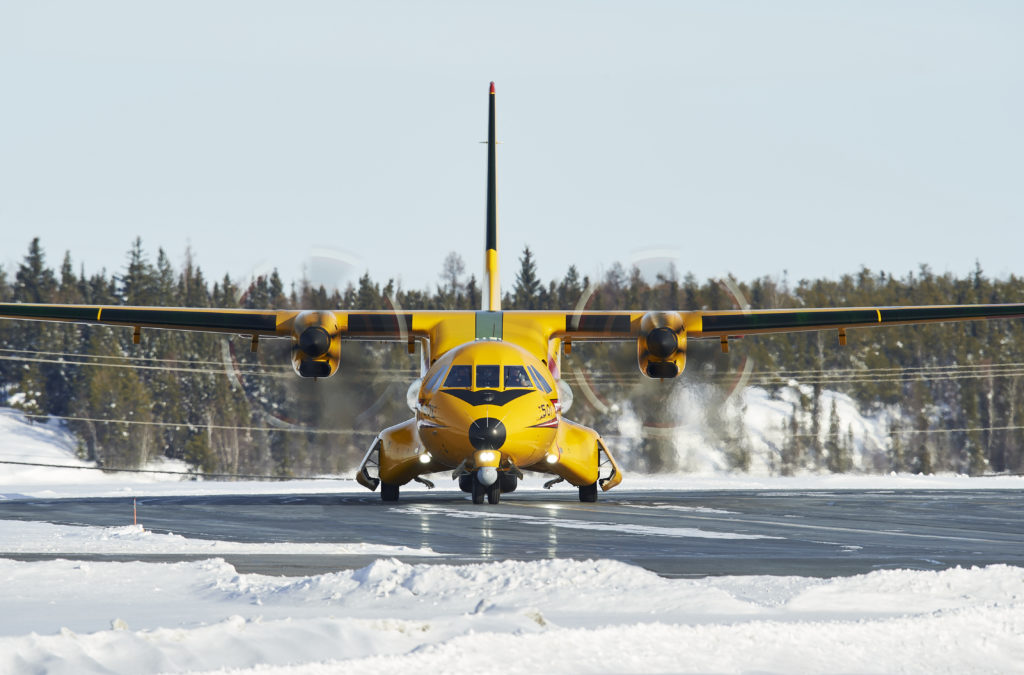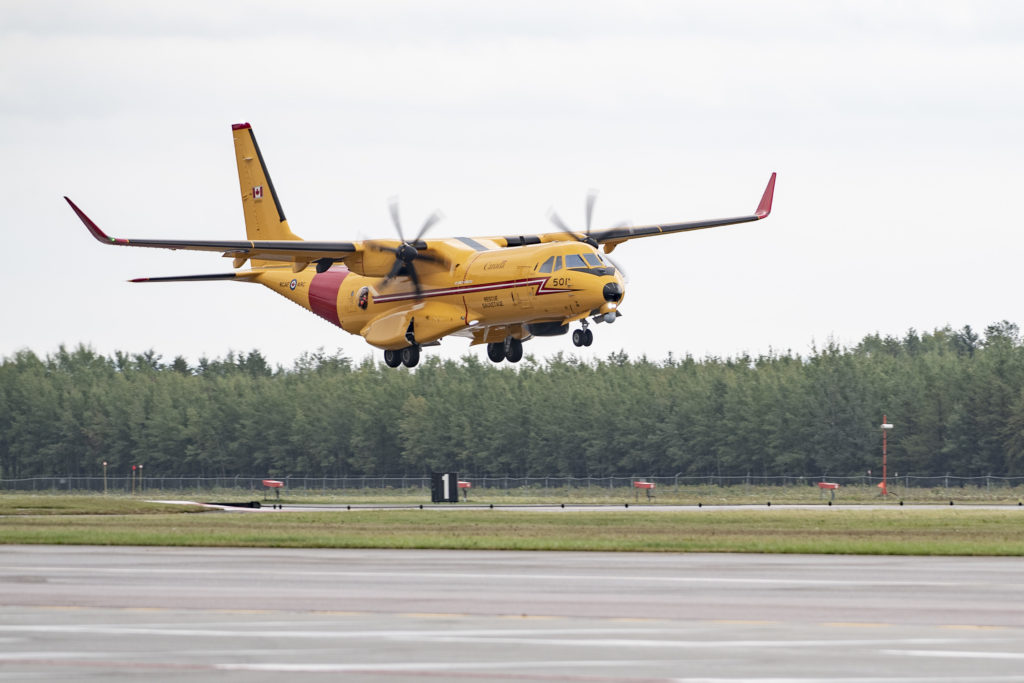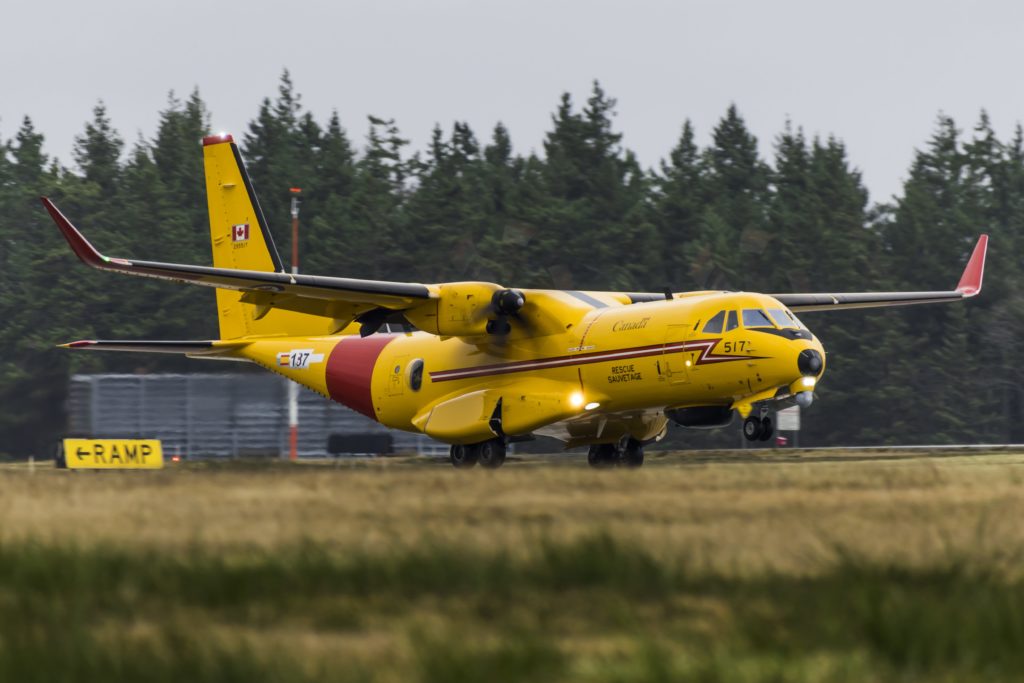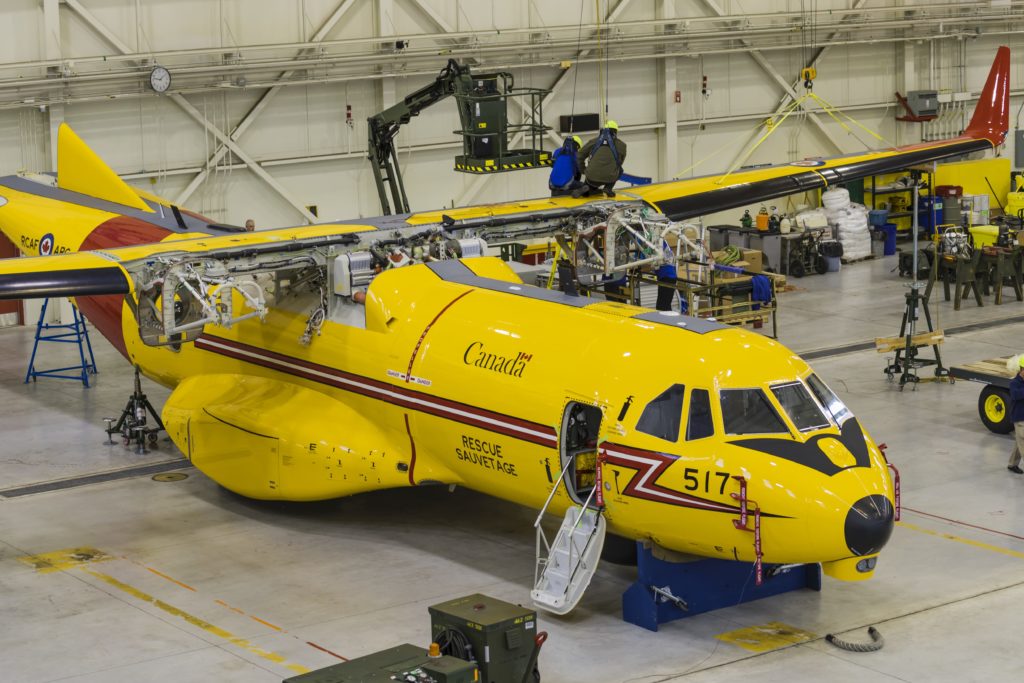Estimated reading time 16 minutes, 55 seconds.
The entry into service of a new military aircraft is always a complex process, and the effects of a delay can ripple through an operational community for some time. The federal government’s admission on May 4, 2022, that the CC-295 Kingfisher won’t be available for fixed-wing search-and-rescue (SAR) operations until the 2025-2026 timeframe is no exception.
Pushing back initial operational capability (IOC) of the CC-295 another three or four years will not only disrupt SAR pilots and maintenance technicians preparing to transition to the new aircraft from the legacy CC-115 Buffalo and CC-130H Hercules, it will also challenge the flexibility and versatility of 435 Transport and Rescue Squadron — and could potentially affect pilot retention at a time when the Royal Canadian Air Force (RCAF) is endeavouring to retain experienced aircrews on operational squadrons.
“I can tell you that as a pilot myself, who was around when we transitioned from the Twin-Huey to the Griffon helicopter, what mattered to me the most was knowing when my conversion course was going to start, when I was to graduate, and where I was going to be posted,” RCAF commander LGen Al Meinzinger acknowledged.

“I know that it is critical that we provide as much certainty as we can to each of our members in terms of their future. As we move ahead, I am confident our measured approach in transitioning to the Kingfisher aircraft will support our members and allow us to do that. I appreciate how important this clarity is for the team.”
When the Canadian government selected the Airbus-built CC-295 in 2016, it forecast IOC for the project – five fully functional aircraft on the ramp at one SAR squadron with the aircrews and maintainers to operate them – by August 2020, and full operational capability (FOC) by 2022. Even as the RCAF began accepting and initiating testing on the first of 16 Kingfishers in December 2019, however, there were warning signs the schedule would need to be adjusted.
“There was an understanding [by the fall of 2020] that there was a lot of work remaining to be done and it would have to be carefully executed in light of the people we have available to get the work done,” said Troy Crosby, Assistant Deputy Minister (Materiel) with the Department of National Defence.
“The extent and complexity of the design changes that had been made and the volume of work that would need to be done to certify … and qualify [the aircraft], and ensure contractual compliance, was going to be massive.”
Though the C-295 is operated by more than 25 countries in a variety of roles, from transport to firefighting, electronic warfare, signals intelligence, and maritime patrol, Airbus made 30 design changes to the platform to meet Canadian mandatory and rated requirements. Among the mandatory changes, for instance, is a cockpit roof hatch to allow the crew quick egress if they ditch in water.
Rated modifications included a heads-up display in the cockpit and enclosing the main landing gear tires that protrude from the underbelly of a C-295 during flight — to improve range and endurance. “[That] was a consideration in the bid evaluation given the size of the country and the mission this aircraft needs to address,” said Crosby.
Airbus also proposed a glass cockpit to improve the quality of its bid and obviate a likely future upgrade. But testing of the avionics uncovered problems with the Crew Annunciation System, which monitors aircraft systems and provides alerts.
“It’s providing alerts to the aircrew that aren’t expected,” Crosby explained. “Airbus has gathered enough information about these anomalies to be able to plan and execute a software update, but software updates in aviation are not straightforward. There is a whole system of testing, certification, qualification that has to be completed.”
One of the knock-on effects to the ongoing certification of design changes is a delay in finalizing operating and maintenance manuals and operating procedures.
“The publications need to reflect the configuration of the aircraft when it is delivered to the aircrew and the maintenance groups,” said Crosby, noting DND was aware of the publications issues even as it was accepting the first aircraft in Spain in late 2019. “Given the extent of the modifications being made to the aircraft and the need to complete testing to confirm performance – for example, the landing gear modification – the pubs were lagging. They weren’t as mature as they needed to be.”

In the fall of 2020, DND subsequently “re-baselined” the schedule, with a new IOC date of mid-2022. But software upgrades, ongoing testing, and complications created by Covid travel restrictions have forced the department to delay the Kingfisher operations until at least 2025.
RIPPLE EFFECTS
On Jan. 15, 2022, aircrews from 442 Transport and Rescue Squadron at 19 Wing Comox, British Columbia, conducted the last operational flights of the CC-115 Buffalo. However, the retirement of the de Havilland Canada-built DHC-5 utility transport turboprop, after almost 55 years of service, has left the Victoria SAR region without a dedicated fixed-wing aircraft to cover an area of over 1.4 million square kilometers of mountainous terrain, and 687,000 sq km of the Pacific Ocean.
The RCAF’s short-term mitigation strategy, called Operation Salus, involves relocating a detachment of two CC-130H Hercules and about 24 aircrew and maintainers from 435 Squadron at 17 Wing Winnipeg, Manitoba, to Comox to respond to calls from the Joint Rescue Coordination Centre in Victoria.
“They are going to remain in situ until such time as we deliver the Kingfisher,” Meinzinger told Skies in an interview. But he acknowledged the burden that could place on a squadron that employs its four H-model Hercules in a variety of roles. In addition to SAR, 435 Squadron has been instrumental in the transport of people from Manitoba communities affected by flooding and forest fires. Moreover, its Hercs are configured for tactical air-to-air refueling and providing a vital training and operational support tanking platform for CF-188 fighter pilots.
“There is an extra line of tasking that we have given to that squadron, so they will be less able to do such things as air-to-air refueling or general air mobility tasks for the CAF,” he said.
The RCAF had planned to retire the CC-130H from its tanking role in the summer of 2021, but the delays with the Kingfisher mean the Hercules will retain the role to augment the Air Force’s two CC-150(T) Polaris strategic tankers on exercises and operations.
“While there will be fewer CC-130Hs and associated personnel in Winnipeg, SAR operations in Search and Rescue Region Trenton will continue to be supported by the CC-130H out of both Winnipeg and 8 Wing Trenton, [Ontario],” the RCAF confirmed in a statement. The interim plan will be adjusted as required.
“We are also exploring the option of using part of the CC-130J fleet to augment the CC-130H in the SAR role.”
The knock-on effects of the delay will also be felt at 418 Search and Rescue Operational Training Squadron in Comox. Home to the RCAF’s SAR schoolhouse, the squadron was ramping up to deliver conversion training to Buffalo and then CC-130H aircrews and maintainers transitioning to the Kingfisher. Though the aircraft maintenance trainer was delivered in early 2020 and initial cadre maintenance training is underway, maintainers can only learn so much without the completed manuals. “We can’t get too far ahead of [ourselves] because if the material is not mature enough, then it is negative training,” Crosby noted.
Similarly for aircrews, while four CC-295s are in Comox and a fifth is expected later this year, and a full flight simulator and other training devices have ben installed in the new schoolhouse, conversion to the Kingfisher has slowed until more of the testing program is complete and operating manuals are final.

“All members [of 442 Squadron] that flew on the Buffalo will be employed in a variety of ways,” the RCAF said in a statement. “Some will train and fly on the CC-130H, some will join and assist with the CC-295 program, some will join other fleets to support other RCAF operations, and some will continue to follow a natural progression and take non-flying positions to support operations in other ways.”
TESTING, TESTING, TESTING
The priority now is completing certification and follow-on operational flight testing and evaluation, said Meinzinger. “We are not going to rush the aircraft testing or the SAR team to initial operational capability. We have a solid mitigation plan in place for the Victoria search-and-rescue region, and we will maintain this mitigation plan as long as necessary until the new capability is fielded.”
Initial cadre training (ICT) on the Kingfisher began in Comox in November 2020 with combined crews comprised of members from 418 Squadron, 1 Canadian Air Division Search and Rescue Standards Evaluation Team (1 CAD SARSET), and 434 Operational Test and Evaluation Squadron. The crews had begun ICT in the fall of 2019 in Seville, Spain, but that was put on pause after several issues were identified, including with the technical publications and checklists related to design changes with the aircraft. The testing resumed in Comox to better manage travel restrictions during the pandemic.
To date, the crews have completed cold soak testing and high intensity radiated fields (HIRF) testing at a range at Naval Air Station Patuxent River, Maryland, to ensure the Kingfisher “can operate safely in the vicinity of a ship that typically is emitting large amounts of electromagnetic energy that could interfere with the aircraft,” said Crosby — a former a flight test engineer who served on the CF-188 Hornet program and as the lead for Fixed Wing Flight Test at the Aerospace Engineering Test Establishment.
Because of the configuration changes to the aircraft, the CC-295 will also undergo contaminated runway friction index testing – slippery runway testing – and a series of other tests that “lead into the initial operational test and evaluation work that develops those aircrew training procedures,” he explained.
Airbus recently completed testing on the calculated air release point software that informs aircrews on when to drop equipment and SAR technicians from the rear ramp “so they will land where they want them to land,” he added.
Though there is now a “defined safe envelop for jumpers to leave the aircraft,” the test teams are still finalizing procedures to retrieve a jumper whose parachute gets snagged behind the airplane. “There is a way of pulling them back into the airplane safely . . . [but] there is still some work to be done there to make sure we have all of that taken care of,” Crosby said.

According to comments on previous Skies articles about the Kingfisher, and social media posts on military aviation channels, the CC-295 has experienced some issues with the center of gravity in the aircraft. SAR community members had input on where search radar and electro-optical/infrared sensor stations were placed, but SAR aircraft carry a lot of additional equipment, and as with all small aircraft, “it comes down to ensuring that it is placed appropriately in the aircraft to maintain that center of gravity,” said Crosby. “If there is challenge because the center of gravity is too far forward or too far back, that can be managed through ballasting.” The crews will have to manage center of gravity.
Given the volume of certification and operational testing remaining, “there is still risk in the schedule at this point,” Crosby acknowledged. “There is a lot of sequencing that has to happen . . . [and] if that first test event runs into challenges, and something is found and it has to be repeated, then it has a consequence on everything that is to come afterwards.”
Nevertheless, ADM (Mat) is forecasting that the project will remain within its expenditure authority. “It is complex work, and it has been made more complex by Covid,” he said.









Should have just got HC130Js and had a common fleet
It’s interesting they didn’t think of these things during the initial bidding process when selecting the aircraft.
Wonder how they came to the determination to buy this aircraft and not another C-130 variant as Con suggests.
Would be nice if we could just buy off the shelf. Canadian lives could be lost due to years of time spent under equipped.
Shorter range, less cargo capability and slower cruising speed along with two engines less for in-your-face weather fighting cap. than the C-130 J for SAR purposes when speed and coastal weather is a factor in Canada. This plane cannot back up the CAF – ATC’s C-130 J’s if ever required to do so. Far too many modifications to be met by Airbus, a non traditional heavy lift supplier for the harsh Canadian CAF environment to satisfy RCAF needs that would have been so much easier for Lockheed to incorporate into new SAR C-130-J’s that are similarly in use by the US Coast Guard for the same SAR purposes. Airbus had to construct a new training ops centre at Comox for crews to train on an entirely new system. For what logical purpose? … the taxpayer should be asking.
Given that this delay was announced so soon after the retirement of the CC-115s, why did they not just extend the service period of the Buffalos, or were they truly at the end of their service life and could not have lasted for another year or two? It’s too bad that the Viking DHC-5NG option was not considered a viable solution at the time of tendering, especially since the Buffalo did seem to offer some unique flight properties.
Another example of incompetence at DND. How the RCAF could have gotten into such a situation is beyond belief.
The problem is that no one is accountable in the RCAF nor the civil service. They bungle away, yet are still entitled to their gold plated government pensions guaranteed by 38 million Canadians.
This would never have happened in the private sector. The culpable actors would have been long ago fired and replaced.
And where were our RCAF leaders?
You’re barking up the wrong tree. You should blame the complete disaster that is the Federal procurement process. The DND and RCAF can only send a list of requirements to the procurement system which then chooses who gets awarded the contract and also how this contract is worded. It is on paper supposed to prevent corruption and waste of funds but the reality of this system is the complete opposite because of many reasons. First problem is that it lets politicians meddle with the process. If you follow the procurement process for the Kingfisher you will find that the contract was about to be awarded to Leonardo with the C27J and then suddenly it was dropped in favor of the C-295. This reeks of the result of political lobbying if you ask me. Secondly it is an extremely unwieldy bureaucratic process that creates a huge disconnect between the manufacturers designing the product and the end-user, getting a Chinese whispers game version of what they asked for with no easy or cheap way to fix it. And finally you have the problem that the contractor’s incentive is to milk as much money as possible out of the Federal government instead of actually supplying a good product and adequately supporting it.
We could waste a decade and hundreds of millions of dollars and end up with a piece of equipment that doesn’t even do the job it was intended for and none of the bad actors in the chain will even get a slap on the wrist. Sadly there is very little political will to fix this problem.
The RCAF likely had little influence on this acquisition.
When I was at Staff College the DM in charge of buying things was a guest speaker, cannot recall the department’s oft changed name at the time. It was my turn to introduce a speaker.
Having coffee with him in the Commandants office before hand he said straight out the selection of our new fighter aircraft would be the aircraft providing the greatest industrial benefit. Full stop.
Doubt very much has changed so do not blame the RCAF for the SAR fiasco.
I thought the C27 was the perfect choice. If I remember correctly it had a lot of shared systems with the C130. Cockpit and engines come to mind. That would have allowed a larger stock of parts to be brought in and shared over a couple airframes, and missions. Seems that would have been a money saver in both parts and labor.